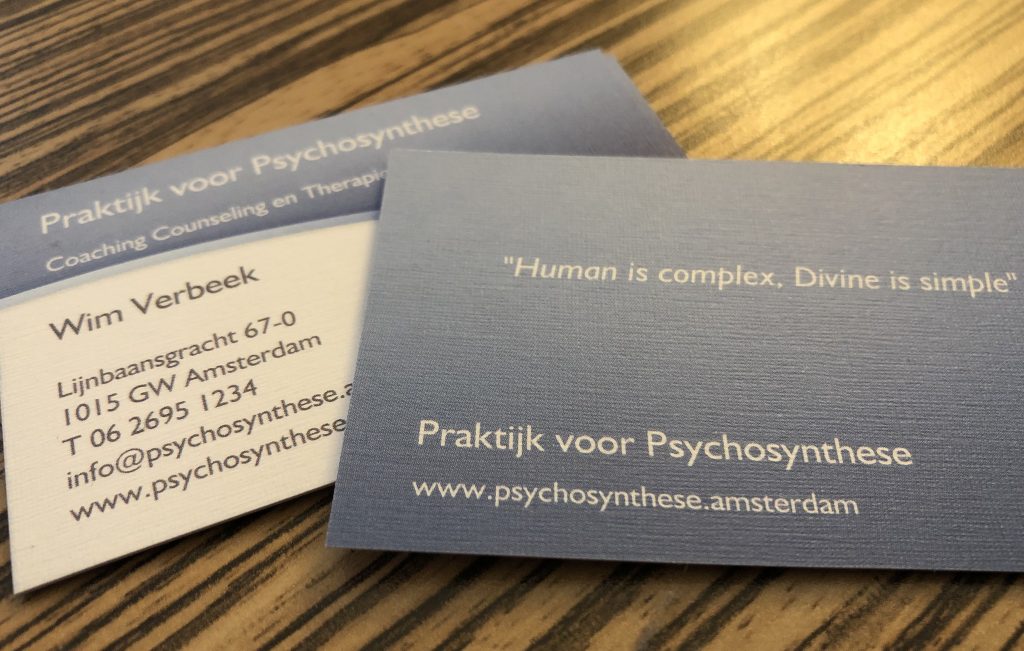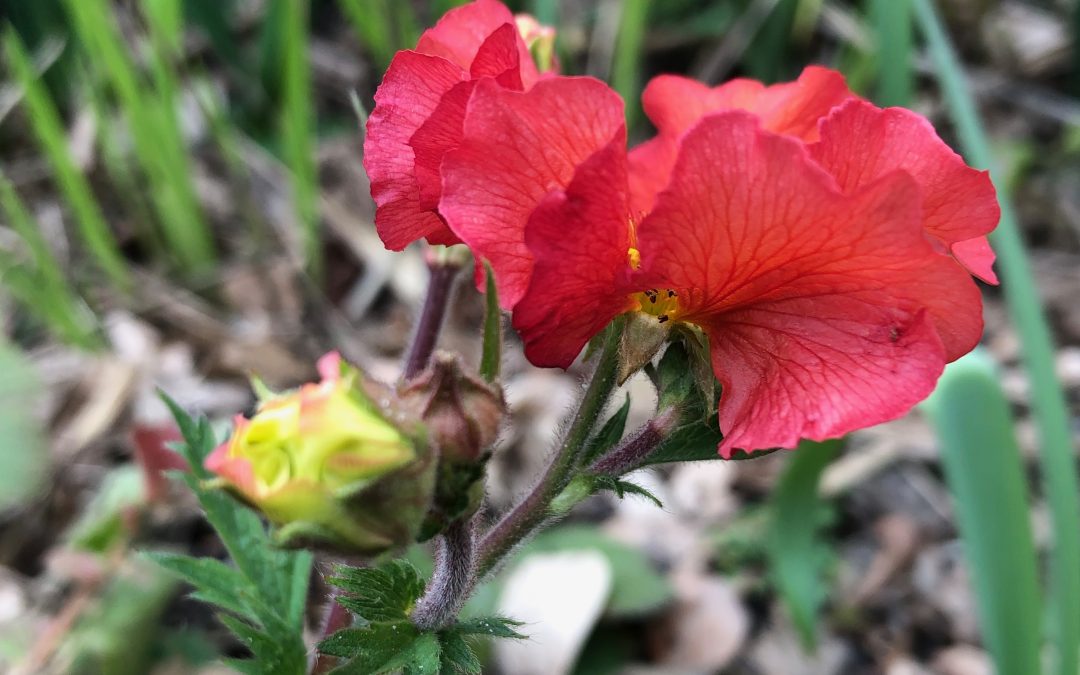“The healthy psychological part of ourselves is capable of appreciating reality as it actually is, and not as one would like it to be”
Franz Ruppert, 2012
The complexity of our personality
Your healthy I, what is that? Do you know yourself? Do you know the difference between a self that is healthy and a self that is not healthy? If you know that and then could and want to live it, then you are a privileged person. On the back of my business card it says: “Human is complex, Divine is simple”. Years ago I came across this text. It hit me right away. On the one hand because it makes me aware of the enormous complexity of our personality that I encounter time and again, both in my own life and in the guidance of my clients. And on the other hand because of the simplicity of the activity of life itself at the moment when we receive more and more awareness in it. How? …… By working hard and persevering on the one hand and doing nothing and letting go on the other. It is a kind of contradiction of life itself that we are all at the mercy of. A constant movement between holding and letting go, between distancing and making contact, between chaos and order, between wholeness and division, between being healthy and not being healthy. In short, the movement of life itself.

Psychosynthesis and working with sub-personalities
Since I have become familiar with Psychosynthesis I have also become more and more familiar with the inner divisions between the different sub-personalities that make up my personality. For example, I got to know an inner perfectionist and critic, but also the nurturing and serving parts of myself. I have become more and more aware of the qualities in which I sometimes have the tendency to shoot through, so that they become distorted and can even cause irritation in the other. And of qualities that, for all sorts of reasons, have not or insufficiently been given space to be lived and visible. I have become more and more aware of these inner dynamics of and between the different parts within myself that on the one hand support me in a healthy and loving life and on the other, parts that are less pleasant to be felt and visible and to allow into my consciousness. This often concerns the parts that have their ‘roots’ in old pain and old experiences of repressed and unauthorized feelings and thoughts. Becoming aware of this inner division is where the Psychosynthesis guidance often starts with. We call that personal psychosynthesis.
Identification and dis-identification
In addition to becoming aware of this inner world of sub-personalities, each with its own energy and activity, with its own feelings, thoughts, perceptions and its own will, there is a great deal of attention for bringing into the consciousness and experience an inner unifying center from which this inner division can be perceived. And what can be recognized and acknowledged as part of the greater whole of who we are. We are a collection of different parts that work together or oppose each other in our personality and that can be experienced and controlled by our consciousness. It is probably one of the most powerful experiences in Psychosynthesis guidance that we can become aware of this inner world of different qualities and energies that work with and sometimes against each other and that we are more than these inner divisions. We are more than our feelings, we are more than our thoughts and we are more than our body. There is a unifying center within each of us where we can perceive ourselves in who we are and where we can make conscious decisions to distance or connect. To hold on to or to let go. It is also the place where we can feel connected to our love and our will and to be unconditional with what is and how life unfolds for us. It is an experience and not a concept. An experience that you can practice through attention. Just as you can get your body in shape and keep it in shape through physical exercises, you can also make your attention for this inner place in yourself more accessible and in your consciousness. In Psychosynthesis we have a wonderful exercise that can support you in this. The identification and dis-identification exercise.
Psychosynthesis and Trauma
The longer I am involved in Psychosynthesis, both in my personal life and in my work as a therapist, the more I focus my attention on the personal ‘work’ instead of the Transpersonal, the Spiritual. The Transpersonal aspect is an important area of focus within the vision of Psychosynthesis, but may and perhaps even should be subordinate to the attention to the personal work that must be done to build a strong personality. I am aware that I cannot transfer the power of the spiritual, the Transpersonal to the client. What I can do is to facilitate the opportunity, together with the client, a place of safety and trust in which to work on a strong personality. Become aware of the inner division and the inner wisdom and strength that is present in each of us. I can support my clients in the process of getting to know themselves, daring to face their own complexity and learn to regain mastery of their own inner world. I am convinced that the Spiritual, the Transpersonal or the ‘Divine’ will then automatically enter the own experience. Divine is simple! Human is complex!
IoPT Identity-Based Psychotrauma Theory and Therapy
In recent years I have become more and more immersed in the Psychotrauma theory of Franz Ruppert and am working more and more to integrate his vision on health and trauma (absence of health) into Psychosynthesis guidance. In his theory Ruppert does not or hardly speak about the Transpersonal and / or the Spiritual aspect in the development of the personality and I also understand why he is careful with that. Spirituality can be a so-called ‘escape route’ (survival part) for some people in order not to really have to connect with the reality of how life takes place in and through us. Where Ruppert’s work is very similar to the vision of Psychosynthesis is the importance of becoming aware of the inner divisions. He uses a simple model for this which makes this inner division visible. He distinguishes between the traumatized part, the survival part and the healthy part. The healthy part in this model most closely resembles the inner place (as described above) from which you can perceive your inner world. In psychosynthesis we call this the inner observer or little self that is free from the content of the personality and perceives without judgment and from which conscious choices can be made. The place where we can connect with free will and unconditional love. Ruppert calls this the healthy self, the healthy I.

A healthy identity is an identity that does not have to split
Both from the perspective of Psychosynthesis and from the perspective of Ruppert’s Psychotrauma Theory, it is only possible to really make contact and make conscious choices from a healthy self, a self that is not identified with the inner divisions of our personality. Because only then can we accept reality as it presents itself, also at this moment in the Covid-19 pandemic as it is, instead of as we want it to be. How we relate to our inner divisions, our healthy selves, and our inner observer determines how we relate to how we currently live in life. How we deal with health and illness, with fear and with trust. With how we go our way in this period of crisis. And although Ruppert’s Psychotrauma Theory does not draw attention to the Transpersonal character of our personality (that our small self or I is a reflection of a greater Self) it facilitates through the Trauma Constellation Method the integration of the inner division. It brings us into contact with our feelings and emotions that are connected to our Trauma Part which is continuously shielded and protected by the Survival Parts. The only purpose of the survival part is to protect the trauma part and to maintain the split-off. And although the trauma part needs to be expressed, heard and seen, it depends on the commitment and presence of the healthy part. According to Ruppert, a healthy identity is an identity that does not have to split!
We will take you to the threshold…..
Both Psychosynthesis counseling and the Psychotrauma Theory of Ruppert want to create a reliable and safe place where the client can encounter himself in his inner division and complexity and can connect and make space for his healthy I, a powerful self. An I that is able to relate to how life unfolds for us in times of anxiety and in times of relaxation, in times of illness and in times of health, in times of strength and in times of weakness. In short, in times of life itself. And I am convinced that when we can connect freely with who we really are, then we feel connected to that which is greater than ourselves. We can read about it and talk about it, agree or disagree. What it really matters is what you experience from your healthy I ! Roberto Assagioli (founder of Psychosynthesis) says somewhere in an article: We will bring you to the threshold and no further … because that is something that is beyond our ability.
Human is complex, Divine is simple
Do you want to learn about your own complexity and encounter yourself in who you are and really face yourself? Then feel welcome in the practice for Psychosynthesis Amsterdam for psychosynthesis counseling and / or an individual trauma constellation IoPT to establish a personal intention (a work question) to take the next step in your own process of inner growth and awareness. A step from division to wholeness! On the way to your healthy self!
Online guidance, therapy and / or IoPT constellation
I offer my services online through CMG CLICKDOC Videoconsult. This means that the practice complies with the privacy rules of the GDPR. You can immediately schedule an appointment for this via the online agenda of the practice. The reimbursements via the supplementary insurance remain the same. At the time of the appointment, you can access the digital waiting room of the Practice for Psychosynthesis Amsterdam via your computer, tablet or smartphone with a personal login code for a video consultation.
And I can imagine that you have doubts about the possibilities and effectiveness of working online via a video connection. I also had my doubts and have overcome the fear and resistance and noticed that we can work very well online and also do an IoPT constellation very well. All you have to take care of is a quiet environment at home where you will not be disturbed and a good and stable internet connection. When in doubt, feel free to contact me, if only to give space to your doubts and where possible to investigate whether it might stand in the way of giving space to your healthy self.
